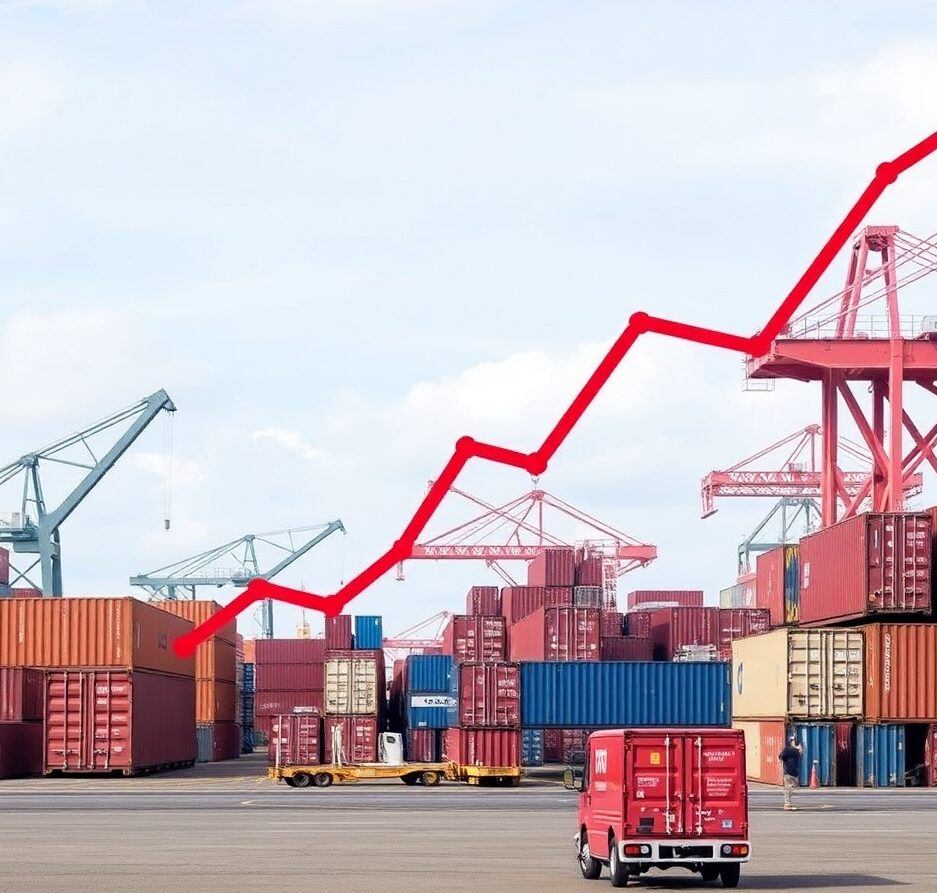
The U.S. trade deficit has been a contentious issue for many years. After fluctuating in recent decades, the deficit is once again on the rise, capturing the attention of policymakers, economists, and the American public. As of late 2024, recent statistics have highlighted a significant increase in the U.S. trade deficit, which now stands at nearly $80 billion for November alone. With this growing gap between imports and exports, concerns about the sustainability of the U.S. economy are resurfacing.
Throughout his political career, Donald Trump has emphasized the need to address this very issue. Under his leadership from 2016 to 2020, the “America First” policy aimed at reducing the trade deficit by renegotiating trade deals, imposing tariffs, and encouraging domestic production. As the 2024 presidential election draws nearer, the question remains: can Donald Trump reverse this growing deficit or is it simply an inherent part of the global trade system? In this article, we will explore the causes of the rising deficit, its economic impacts, and whether Trump’s proposed solutions can make a difference.
Understanding the U.S. Trade Deficit
To understand the current rise in the U.S. trade deficit, it’s essential to define what a trade deficit is. A trade deficit occurs when a country imports more goods and services than it exports. For the U.S., this imbalance is substantial, as the country consistently imports a wide variety of goods—ranging from electronics and vehicles to clothing and petroleum—while its export market struggles to keep pace.
In the latest data from November 2024, the U.S. recorded an increase of 4.8% in its trade deficit, which reached $80 billion. This marks a concerning rise, indicating that the balance of trade is continuing to shift in favor of foreign countries. A trade deficit is not inherently bad, but if it persists over time, it can indicate larger economic challenges, such as an unsustainable reliance on foreign goods, rising consumer debt, or a weakening domestic manufacturing base.
The U.S. has seen its trade deficit rise in recent years for several reasons. One of the most significant drivers is the strong U.S. dollar. While a strong dollar is usually good for U.S. consumers because it makes foreign goods cheaper, it also makes American products more expensive abroad. This reduces demand for U.S. exports, thereby exacerbating the trade imbalance. Moreover, the global economic recovery from the pandemic has driven demand for goods from China, Europe, and other manufacturing hubs, resulting in an increased import of products.
Factors Contributing to the Rising Trade Deficit
Several factors have contributed to the rise in the U.S. trade deficit, making it more challenging to balance. These include global economic trends, domestic consumption patterns, and trade policies of other nations.
Global Economic Recovery
As countries around the world continue to recover from the COVID-19 pandemic, global trade has surged. The U.S., with its strong domestic demand, is importing a large number of goods to meet consumer needs. This increased demand for foreign products, particularly from countries like China and Germany, has been a primary contributor to the widening trade gap.
China, in particular, remains a major trade partner for the U.S. Despite the trade war during Trump’s administration, the importation of goods from China, particularly electronics, machinery, and other industrial products, has remained high. The demand for these products in the U.S. remains strong, as American consumers continue to purchase affordable imported goods.
The Strong Dollar and Its Impact
The U.S. dollar is one of the strongest currencies globally, and while this benefits U.S. consumers in terms of lower prices on foreign goods, it also makes U.S. exports more expensive for buyers in other countries. As a result, U.S. exporters struggle to compete with foreign competitors who can offer cheaper products. The strong dollar thus discourages foreign countries from purchasing American-made goods, further contributing to the trade deficit.
Shifts in Domestic Consumption
Increased domestic consumption is another major factor contributing to the U.S. trade deficit. Since the recovery from the pandemic, American consumers have been more inclined to spend, purchasing everything from electronics to vehicles. However, much of what they are purchasing is imported. This higher consumption rate has driven the demand for foreign goods, leading to a broader trade imbalance.
The Decline in Domestic Manufacturing
One of the more complex factors behind the rising trade deficit is the decline in domestic manufacturing in the U.S. Over the past few decades, many American manufacturing jobs have been outsourced to other countries where labor is cheaper, particularly in Asia. As a result, the U.S. has become more reliant on imports to meet its needs, particularly for consumer goods. The shift away from manufacturing has left many sectors unable to keep pace with global competitors, exacerbating the trade imbalance.
The Impact of the Rising Trade Deficit
The rising trade deficit has several economic implications, some of which are more immediately concerning than others. It is essential to understand the broader effects of this imbalance, not just on the economy but also on American workers, businesses, and consumers.
Economic Growth and Debt
At its core, a trade deficit means the U.S. is importing more than it is exporting, leading to a net outflow of money to foreign countries. While the U.S. economy is still growing, a growing deficit signals a potential over-reliance on foreign capital. The U.S. must finance the deficit by borrowing from other countries, which can increase national debt and make the U.S. economy more vulnerable to global economic fluctuations.
Additionally, the U.S. relies on foreign nations, particularly China and Japan, to purchase U.S. Treasury bonds, which helps to finance its deficit. If foreign demand for U.S. debt decreases, the country may face higher borrowing costs or a loss of confidence in its economic policies.
Job Losses in Domestic Manufacturing
As the U.S. imports more goods than it exports, domestic manufacturing industries may suffer. Industries such as textiles, steel, and electronics are directly impacted by cheap foreign imports, which can lead to job losses and the outsourcing of labor to countries with lower labor costs. This affects middle-class workers who rely on manufacturing jobs, and the ripple effects can be seen in communities across the country that once depended on these industries.
While certain sectors of the economy benefit from trade—such as the tech industry, which relies on imported components—other sectors are struggling to maintain their footing. This job displacement has been one of the most pressing concerns for policymakers in addressing the trade deficit.
Weaker Dollar and Inflation Risks
A prolonged trade deficit could lead to a weaker U.S. dollar over time. A weakened dollar would make imports more expensive, resulting in higher inflation. As foreign products become more costly, U.S. consumers may face increased prices on everyday goods, which would negatively impact purchasing power.
The inflationary effects could extend beyond just consumer goods. As the cost of imported raw materials rises, production costs for U.S. manufacturers could also increase, leading to higher prices across various sectors, from food to energy.
Trump’s Economic Policy on Trade Deficits
When Donald Trump became president, he made it clear that addressing the U.S. trade deficit would be one of his top priorities. His “America First” policy aimed at reducing the trade imbalance through protectionism, renegotiating trade deals, and imposing tariffs on foreign goods.
Tariffs and Trade Wars
One of Trump’s primary tools for addressing the trade deficit was the use of tariffs. He imposed tariffs on a variety of products, particularly from China, which was seen as the main culprit behind the U.S. trade imbalance. The tariffs were intended to make foreign goods more expensive and encourage American consumers to purchase domestically-produced items.
While Trump believed tariffs would help reduce the trade deficit in the short term, the long-term effects have been more complex. Tariffs resulted in retaliatory tariffs from other countries, such as China, Canada, and the European Union, which hurt U.S. exporters, particularly in agriculture. This trade war resulted in significant uncertainty, particularly for American farmers who found themselves facing barriers to their primary export markets.
The USMCA and Trade Negotiations
Trump also renegotiated trade deals, most notably the North American Free Trade Agreement (NAFTA), which he replaced with the United States-Mexico-Canada Agreement (USMCA). The new agreement aimed to increase U.S. exports to Canada and Mexico, particularly in sectors like agriculture, dairy, and automobiles. By updating the terms of trade with these two key partners, Trump hoped to bring more balance to trade relations with North America.
While the USMCA was hailed as a win for U.S. farmers and manufacturers, its impact on the broader trade deficit was mixed. The U.S. still imports more than it exports to countries like China and Germany, and the trade deficit with these countries remains substantial.
Global Trade Dynamics and Its Impact on the U.S. Deficit
In addressing the U.S. trade deficit, it is crucial to recognize the global nature of modern trade. Many factors, including currency fluctuations, global supply chains, and trade policies of other nations, influence the trade balance.
Currency Devaluation and Trade Imbalances
Many countries, particularly China, have been accused of manipulating their currencies to make their exports cheaper. By keeping their currencies undervalued, these nations can flood global markets with inexpensive goods, making it harder for U.S. manufacturers to compete. As a result, U.S. imports rise, contributing to the growing deficit.
Global Supply Chains and Outsourcing
The modern global economy relies heavily on global supply chains, where products are sourced from multiple countries, often with cheaper labor and materials. As more and more goods are outsourced to low-cost producers abroad, the U.S. imports more products, leading to a widening trade deficit.
Trump’s attempts to bring manufacturing jobs back to the U.S. through tariffs and incentives faced challenges in reversing this trend. The global nature of supply chains means that even small shifts in production can have significant effects on trade flows.
Can Trump Do Anything About the Rising Deficit?
The rising trade deficit presents a tough challenge for any president. While Trump’s policies did have some impact on certain sectors, the broader issue of the U.S. trade imbalance remains entrenched in global economic dynamics. If Trump were re-elected, it is likely that he would continue to push for trade policies that favor U.S. industries, particularly in manufacturing and agriculture. However, the effectiveness of these policies is uncertain, as tariffs and protectionist measures may have unintended side effects.
Ultimately, addressing the rising trade deficit requires a multi-faceted approach that includes both domestic policies and international cooperation. While Trump’s leadership and policies may have some influence, the global economy’s complexity means that the solution to the trade deficit may lie beyond the control of any single administration.
The U.S. trade deficit is once again rising, and as the 2024 election draws near, Donald Trump’s policies will undoubtedly come under scrutiny. Whether or not he can reverse this growing imbalance remains uncertain. While tariffs and trade deals have been central to his strategy, the broader economic dynamics at play—such as the strength of the dollar, global supply chains, and the policies of other nations—make the trade deficit a persistent challenge. Ultimately, a balanced approach will be necessary to tackle the deficit while maintaining the U.S. economy’s global competitiveness.
Feel free to check out our other website at : https://synergypublish.com

